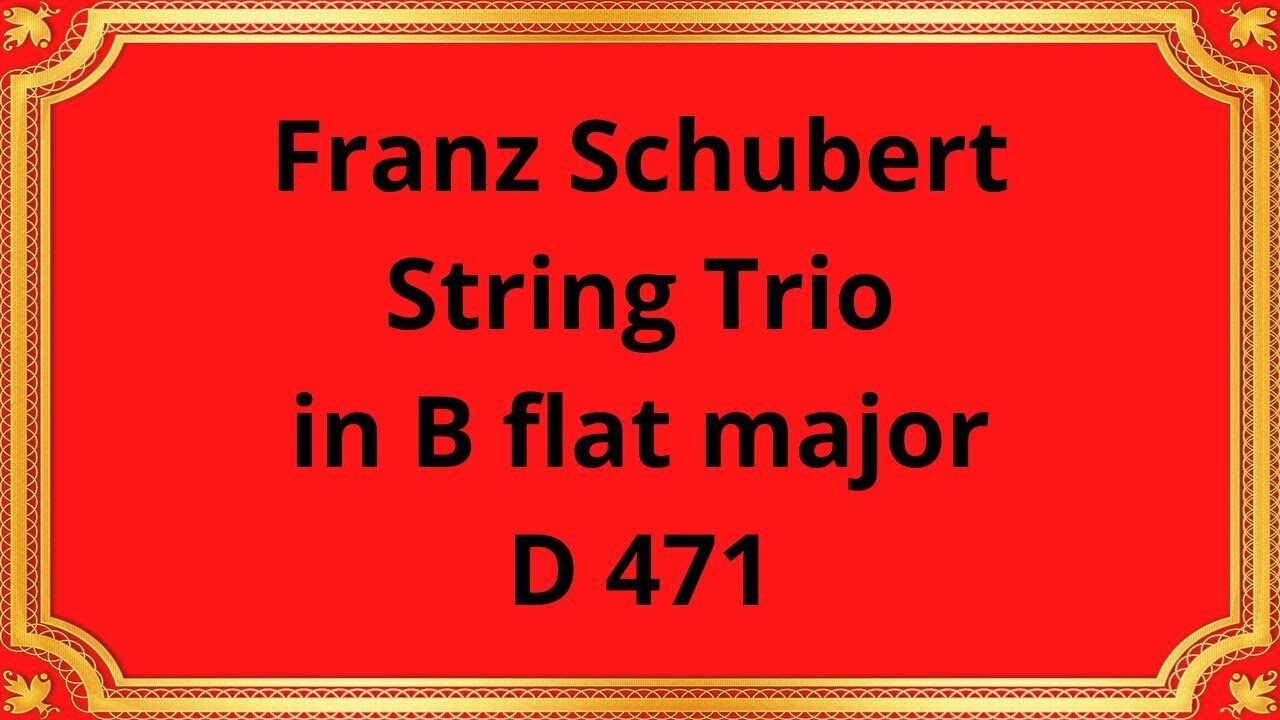Premium Only Content

Franz Schubert String Trio in B flat major D 471
#classicalmusic #FranzSchubert #StringTrio #Bflatmajor #D471 #musicalcomposition #VienneseClassical #chambermusic #stringensemble #FranzSchubertStringTrio
Publication date 1935
Edgar Ortambert (violin)
Georges Drouet (viola)
Louis Ruyssen (cello)
Franz Schubert, a renowned composer of the Romantic era, left a profound impact on the world of classical music. Among his vast repertoire, the String Trio in B flat major D 471 stands out as a captivating and enchanting composition.
Franz Schubert composed the String Trio in B flat major D 471 in 1816, at the age of 19. It was a time when Schubert was exploring the possibilities of chamber music, following the traditions set by Mozart and Haydn. The trio was written during his early years in Vienna, a fertile period that witnessed his tremendous growth as a composer.
The trio is composed for three string instruments: violin, viola, and cello. This combination creates a rich and balanced texture, allowing each instrument to shine individually while blending harmoniously together.
The composition follows the traditional four-movement structure:
1. Allegro: The opening movement is characterized by its joyful and lively nature, showcasing Schubert's melodic brilliance.
2. Adagio: The second movement presents a contrasting mood, featuring a lyrical and introspective melody that exhibits Schubert's expressive depth.
3. Menuetto: This minuet and trio movement displays a graceful and elegant dance-like quality, with its rhythmic patterns and charming melodies.
4. Allegro: The final movement, marked by its energetic and spirited character, brings the trio to a thrilling and triumphant conclusion.
The String Trio in B flat major D 471 exemplifies Schubert's gift for crafting captivating melodies. Throughout the composition, Schubert weaves intricate and memorable themes that are both emotionally resonant and musically engaging.
Schubert's harmonic language in this trio showcases his ability to create lush and unexpected chord progressions, adding depth and complexity to the overall musical experience.
The composition's inherent intimacy and interplay between the three instruments highlight Schubert's mastery of chamber music. The trio allows each instrument to shine individually, while also emphasizing the importance of collective musical dialogue.
Conclusion:
Franz Schubert's String Trio in B flat major D 471 is a remarkable musical composition that showcases the brilliance and creativity of one of the greatest composers of the Romantic era. With its enchanting melodies, intricate harmonies, and deft chamber music writing, this trio remains a cherished gem in the world of classical music. Its enduring beauty continues to captivate audiences, ensuring its place as a significant contribution to the chamber music repertoire.
You have the opportunity to support the channel:
https://destream.net/live/RadSiarAl/donate
https://www.buymeacoffee.com/6355radsiaral
-
 20:26
20:26
Classical music_Music Inspiration
1 month agoJohann Sebastian Bach Orchestral Suite No. 2 in B minor, BWV 1066
862 -
 LIVE
LIVE
LumpyPotatoX2
3 hours agoKilling Floor 3 + SoulFrame: Co-op Showcase - #RumbleGaming
126 watching -
 LIVE
LIVE
TheItalianCEO
3 hours agoPlaying video games on a Sunday since 1989
271 watching -
 28:43
28:43
Liberty Hangout
3 days agoAnti-Trumpers Don't Know What They're Protesting
27K175 -
![[GB]Long Stream?!?! ✨ Turtle Beach Partner !TB](https://1a-1791.com/video/fww1/20/s8/1/K/9/Z/5/K9Z5y.0kob-small-GBLong-Stream-Turtle-Beach-.jpg) LIVE
LIVE
OneRandomDolly
2 hours ago[GB]Long Stream?!?! ✨ Turtle Beach Partner !TB
153 watching -
 20:33
20:33
Sideserf Cake Studio
1 day ago $3.19 earnedI Built A Bikini Bottom Fish Tank CAKE!
22K11 -
 LIVE
LIVE
Atarithepaladin
14 hours agoPaladin Playthrough Ep 17
147 watching -
 10:35
10:35
Warren Smith - Secret Scholar Society
1 day agoExposing the Illusion of Gary's Economics
57.9K11 -
 13:14
13:14
Michael Button
1 day ago $3.16 earnedThere’s a Giant Hole in Human History
26.7K23 -
 9:23
9:23
Russell Brand
22 hours agoThe TRUTH Behind Stephen Colbert's Downfall
66.6K87